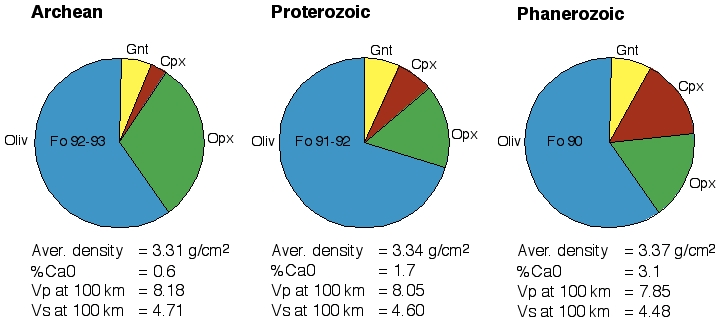PETROLOGIC AND GEOPHYSICAL CHARACTERISTICS OF THE LITHOSPHERE and the LITHOSPHERE-ASTHENOSPHERE BOUNDARY THROUGH TIME
S.Y. O'Reilly1, W.L. Griffin1,2
1. GEMOC Macquarie
2. CSIRO Exploration & Mining
The lithosphere-asthenosphere boundary (LAB) is an interface that reflects the fundamental evolution of the Earth into major geochemical reservoirs driven by global thermal processes. The Earth's lithospheric mantle is non-convecting (in contrast to the asthenosphere) and does not mix or homogenise easily: therefore it carries a geochemical imprint of major melting events and subsequent fluid fluxes (metasomatism). As a generalisation, lithospheric mantle has undergone significant (probably multiple) melting and is depleted in "basaltic" components such as Fe, Al, Ca and Ti. Asthenosphere by contrast, is "fertile" (rich in basaltic components) and geochemically more homogeneous than lithosphere because it is convecting.
The depth to the LAB varies significantly with the tectonothermal age of lithosphere domains and is a function of the geochemical nature of the lithospheric mantle column and its thermal state which determine its density and rheological response. Mantle xenoliths and their disaggregated minerals (especially garnet and chromite) brought to the surface in basalts and kimberlites, can be used to construct sections of the rock types and their spatial distribution with depth in the lithospheric mantle, to estimate empirical palaeogeotherms, and to locate the depth to the LAB (O'Reilly and Griffin, 1996). This geochemically determined depth coincides with estimations of depth using geophysical datasets, especially seismic refraction and magnetotelluric.
We have also established (Griffin et al, 1998; 1999) that the mean geochemical composition of the subcontinental lithospheric mantle beneath terranes with Archean, Proterozoic and Phanerozoic crustal tectonothermal ages shows an episodic secular and apparently irreversible change with time. Younger lithospheric mantle is progressively less depleted in "basaltic" components. Using average mineral compositions measured from xenoliths, these compositions have been recast into mineral assemblages (modes), and used to derive the mean density and seismic velocities for mantle lithosphere of different ages (Figure 1). Archean lithospheric mantle is much less dense than Phanerozoic mantle, but has higher seismic velocities at any temperature; Proterozoic mantle lies between these two end-members.
This correlation of mantle composition with crustal age has important implications:
- The crust and the underlying lithospheric mantle must have formed quasi-simultaneously, and they typically have stayed coupled for periods of aeons
- There must have been major changes in Earth's geodynamics about 2.5 Ga ago, which changed the way continents and their roots are formed
- Since 2.5 Ga, the continent-forming processes have evolved toward lower degrees of partial melting; this suggests a link to the secular cooling of Earth
Archean lithosphere is refractory, and too buoyant to be "delaminated" by gravitational or thermal effects and this may explain the longevity and stability of Archean keels. Replacement of Archean lithosphere must involve mechanical dispersal (eg during rifting) and may be accompanied by thermal and chemical erosion as hot, fertile asthenospheric material rises; the tectonic consequences at the surface include uplift, magmatism and basin formation during subsequent thermal relaxation. Such lithosphere replacement events may be important in producing fluids and structures seen in the lithospheric mantle as metasomatic episodes.
REFERENCES
Griffin, W.L., O'Reilly, S.Y., Ryan, C.G., Gaul, O. and Ionov, D. 1998. Secular variation in the composition of subcontinental lithospheric mantle. In J. Braun, J. C. Dooley, B. R. Goleby, R. D. van der Hilst and C. T. Klootwijk (eds) Structure and Evolution of the Australian Continent, Geodynamics Series, Vol. 26, Amer. Geophys. Union, Washington D.C. p. 1-26.
Griffin, W.L., O'Reilly, S.Y. and Ryan, C.G. 1999. The composition and origin of subcontinental lithospheric mantle. In: Y.Fei, C.M. Bertka and B.O. Mysen (eds.) Mantle Petrology: Field observations and high-pressure experimentation : A tribute to Francis R. (Joe) Boyd, Geochemical Society Special Publication #6, The Geochemical Society (Houston). In press.
O'Reilly, S.Y. and O'Reilly, W.L., 1996. 4-D Lithosphere Mapping; methodology and examples.Tectonophysics, 262: 1-18.
Figure 1: Differences in mantle mode, composition and physical properties
for Archean, Proterozoic and Phanerozoic lithospheric mantle.


 GEMOC ARC National Key Centre
GEMOC ARC National Key Centre